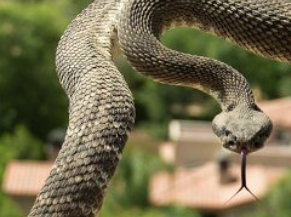Rattlesnakes usually stay away from humans, but health officials say about 8,000 people are bitten by venomous snakes in the country every year. Snakes bites are most prevalent between April and October and are on a record pace this year, according to many poison control centers. It doesn’t seem to matter if you are on the East Coast or the West Coast, or down South— location doesn’t matter. Snakes are very temperature-dependent, so it’s more a matter of warm weather than a particular state or region. 
The number of calls last month to the Carolinas Poison Center about snake bites nearly quadrupled compared to last year. More than 500 calls about snake bites are expected in California. Georgia Poison Control reports a 50 percent increase in the number of bites reported this year compared to the same time period last year. This is a small sampling, but represents what most states are experiening in late summer.
A few species seem to cause the majority of poisonous bites: copperheads, cottonmouths (also called the water moccasin), eastern diamondback rattlesnakes, pigmy rattlesnakes, timber rattlesnakes, and sidewinders. It's true that there are ways to tell if a snake is venomous by its appearance, but most people aren't paying close enough attention to really know. It's better to assume ALL snakes are poisonous and avoid them. Don't be afraid to be outside, just be cautious and know what poisonous snakes look like that are common to the areas where you recreate and live. A rattlesnake, for example has a broad, triangular head. It has a relatively heavy or "fat" body, with a rattle on tail. The rattlesnake’s signature sound is a lot like bacon sizzling. However, these venomous creatures can lose their rattles over time, so don’t be lulled into a false sense of safety because you hear nothing. Even when not fatal, snake bites can be painful and scary. Bottom line: it's better to be safe than sorry, so follow these tips when in snake country no matter the state:
- Be alert. Like all reptiles, snakes are sensitive to the ambient temperature and will adjust their behavior accordingly. After a cold or cool night, they will attempt to raise their body temperature by basking in the sun midmorning. To prevent overheating during hot day, they will become more active at dawn, dusk or night.
- Wear sturdy boots or gaiters. Kid size snake chaps are worth considering, too. Never go barefoot or wear sandals when walking through brushy, wild areas. Startled snakes may not rattle before striking defensively. Children should not wear flip-flops while playing outdoors in snake country.
- When hiking, stick to well-used trails. Avoid tall grass, weeds and heavy underbrush where snakes may hide during the day. Never hike alone. Always have someone with you who can assist in an emergency.
- Do not step or put your hands where you cannot see. Step on logs and rocks, never over them, and be especially careful when climbing rocks or gathering firewood. Check out stumps or logs before sitting down, and shake out sleeping bags before use. Be careful when trimming tall weeds or working around wood piles even in your own backyard.
- Never grab “sticks” or “branches” while swimming in lakes and rivers. Rattlesnakes can swim! It’s not known why they take to the water, other than sometimes to escape predators.
- Teach children early to respect snakes and to leave them alone.
- Leash your dog when hiking in snake country so they can’t poke their noses into holes where a rattler might be hiding.
If you do get bitten, don’t try using an ice compress or a tourniquet. Don’t try “cutting and sucking.” Seek immediate medical attention and take comfort in the fact that the bites may cause intense, burning pain but are rarely fatal, unless it is a child or pet, in which case a bite can be deadly. Once at a hospital, treatment depends on the type of snake involved, the amount of venom injected and the health of the person bitten. If your dog is bitten, take it to the veterinarian immediately to receive the antivenin treatment.
Although snakes of any kind are not "out to get you," bites can and do occur. Your best defense is don't take a chance! Wear snake gaiters or snake pants when in known snake country - whether that be the desert or woods - and greatly reduce your chances of being bitten!